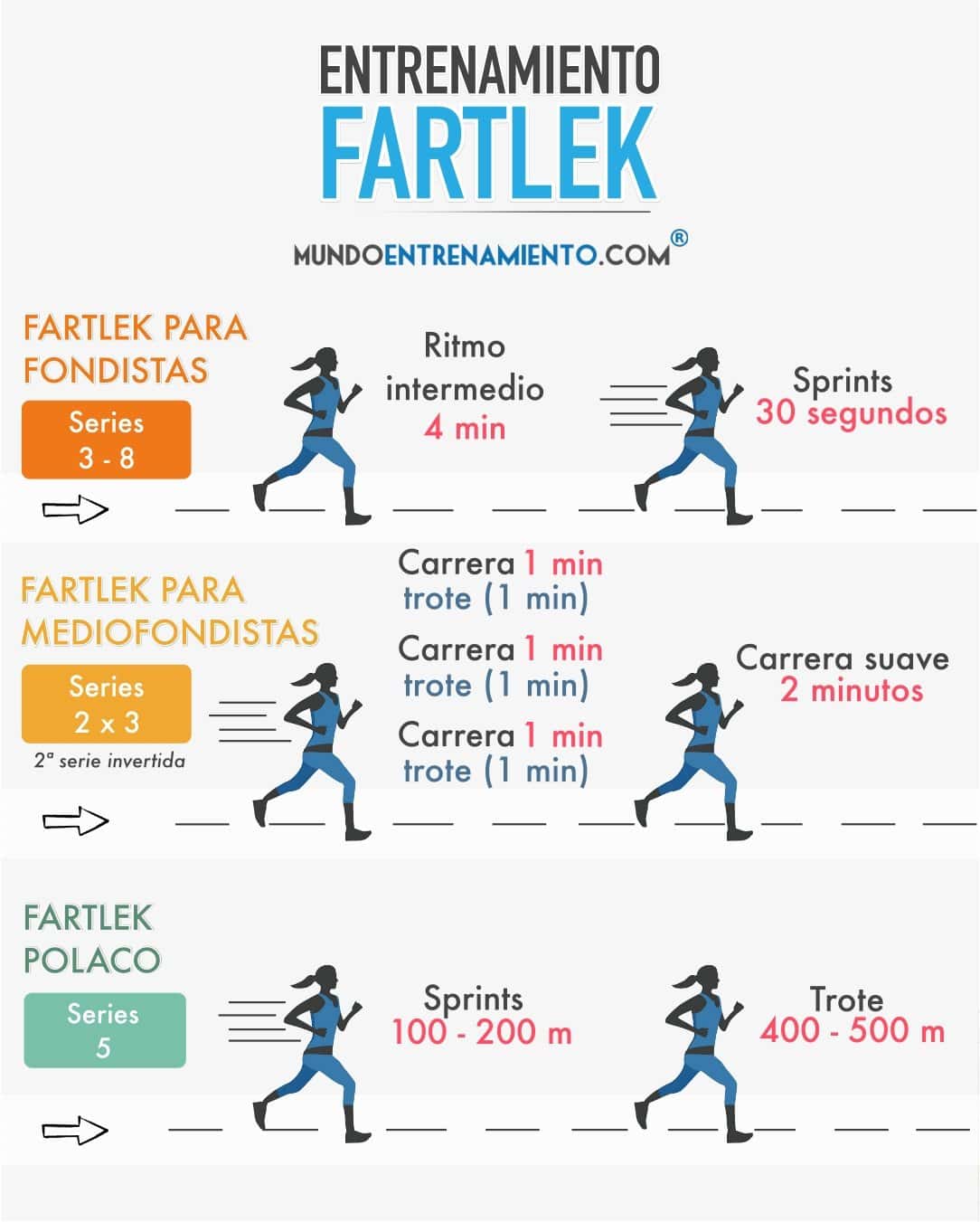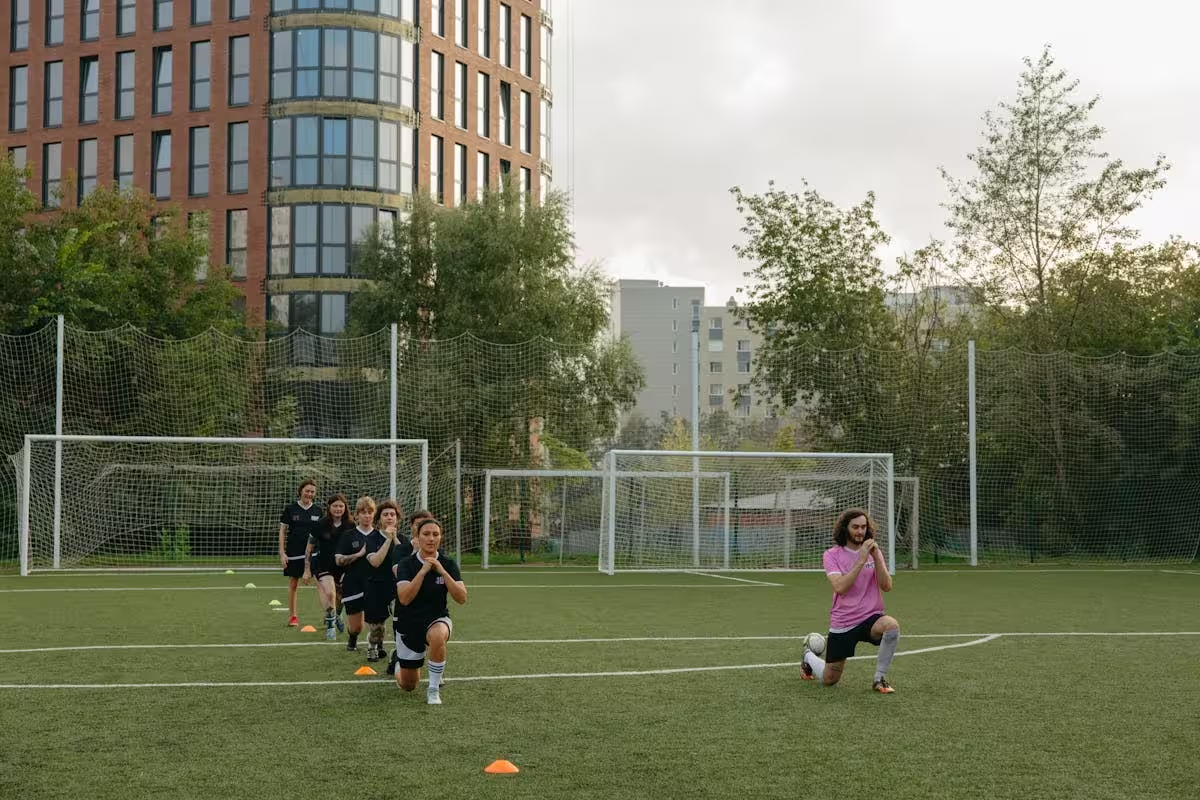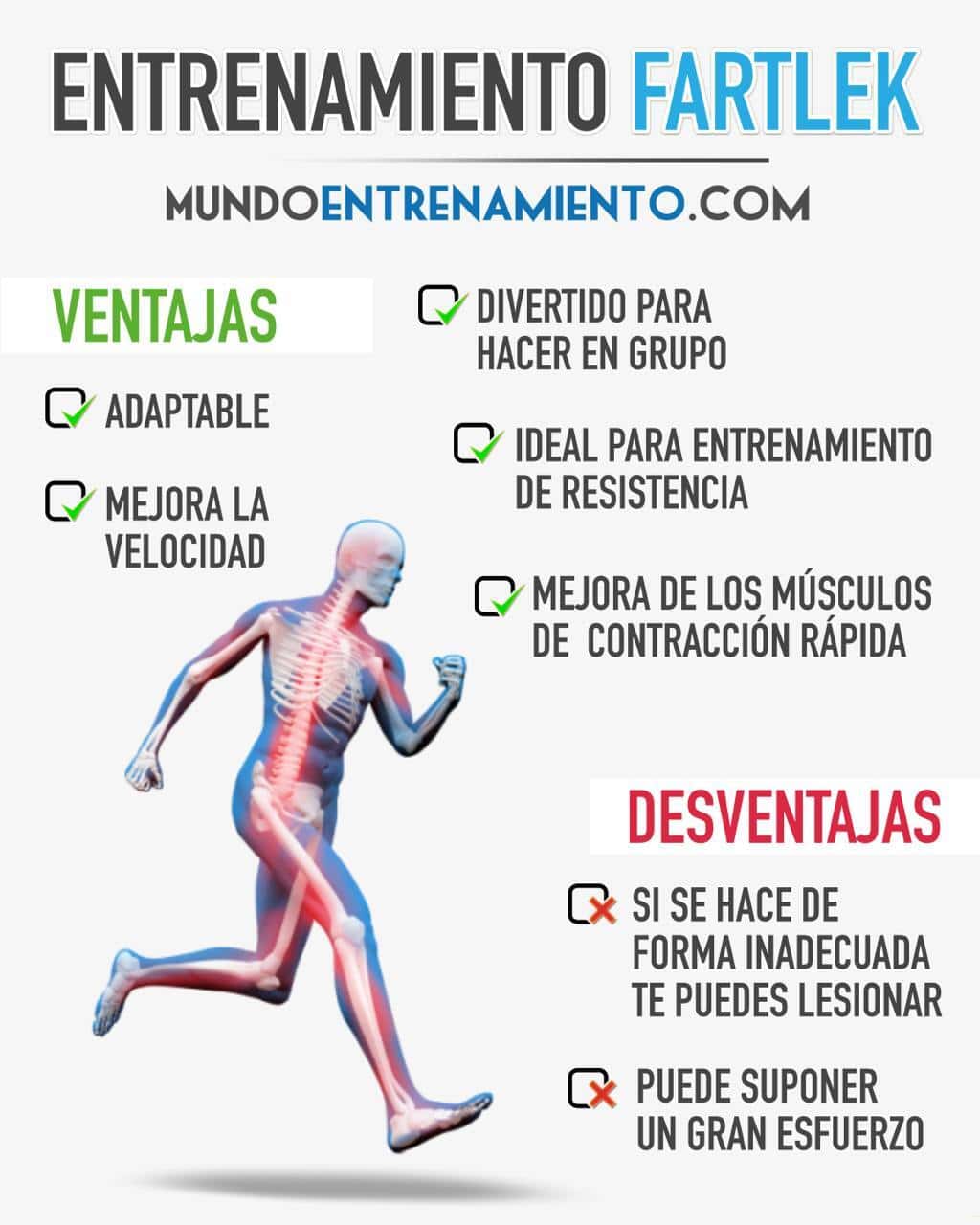The Fartlek method aims to improve endurance; in this article, we will discuss this interesting method in detail.
Fartlek what is it? What is its method and how to perform it?
The fartlek basically consists of performing different pace changes with time intervals, whose objective is to improve endurance, and it can be ideal for athletes and distance runners to improve their marks.
This training system was created in Sweden in the 1930s, with Gosta Holmer being its main architect. Also, if the person is a beginner in endurance training, it is not considered appropriate to practice it since there are more basic ways to start (1).
Therefore, Luna, L. (2022), mentions that it is not advisable to use this type of training system with beginners, as the accumulation of kilometers should be progressive.
As already answered to fartlek what is it, we will highlight that fartlek is a good method to improve the runner’s endurance, whether at the beginner or elite level, and it also allows working on endurance and speed at the same time (1).
And so the best answer to fartlek what is, consists of performing a determined running time, and within it adding small intervals of pace acceleration. We will see it with a simple example:
- It consists of making pace changes within the same medium-paced run.
- Start with 5 minutes of jogging at a moderate pace, and after completing the 5 minutes, perform 30 seconds of acceleration, and after finishing the 30 seconds, continue for another 5 minutes at a constant pace.
- This sequence can be performed as many times as necessary, depending on the training objective.
- It is also important to have a watch or programmed stopwatch with the times to carry it out (1).
In the words of Luis Miguel García, cited in Luna, L. (2022), it is clear that “the fartlek is a great system to improve the runner’s endurance, whether popular or elite”.
That said, it is clear that this method can be incorporated into the training of changing running paces since, as observed, it would work on endurance and speed at the same time.
On the other hand, Fartlek comes from the Swedish fart (which means speed) and lek (play), where playing at different speeds is combined, as stated by Guzmán Colón, C.A. (2020), which is one of the most used methods today.
In other words, its duration should not exceed one hour due to the lack of Oxygen (5).
What are the objectives of the Fartlek method?
The Fartlek method arises from the need for work on different terrains and in Cross Country competitions, with which this Swedish method has different objectives for those who carry it out.
After which, Guzmán Colón, C.A. (2020), mentions the different objectives of the fartlek method:
- Focus on endurance and speed training based on intervals.
- Aim for the body to adapt to specific changes in any terrain, based on pace and speed changes.
- Program and change the paces, adjusted to the terrain variables.
- Facilitates endurance and speed work in different natural spaces.
- Combine with aerobic and anaerobic work (terms used differently today).
Main characteristics of the Fartlek method
This training method becomes interesting due to the versatility it generates in those who perform and practice it, remembering that it can be applied to runners, swimmers, or cyclists of different levels. That said, Paz Guachilema, H. S. (2023), mentions different characteristics of the Fartlek method:
- Allows variability in the use of terrains, which generates constant adaptations in concentration and at a cognitive level for those who practice it.
- Variability of different running paces within the same race. Slow and fast running.
- Variation of respiratory and heart rate.
- Its execution time is taken as a base between 8 to 12 minutes to start.
These characteristics are part of the Fartlek training, where aerobic work combined with anaerobic work predominates.
Classification of the Fartlek method
The Fartlek method can be classified in two ways, as Swedish Fartlek which focuses on times and natural scenarios, and Polish Fartlek, where the work focuses on different distances and running circuits (4).
Below is information about Polish Fartlek, according to data from Guzmán Colón, C.A. (2020).
It is recognized as a joyful training, lasting 45-60 minutes, with variable intensity.
As an example, one of the ways to organize Polish Fartlek training is in 4 parts:
- Part: Warm-up, lasting 5 to 10 minutes.
- Part: 40 minutes of pace work over short distances, 20 to 45 seconds.
- Part: 30 minutes of pace work over long distances, 60 to 90 seconds.
- Part: 10 to 15 minutes of cool down with slow activities.
Once these data are taken as a base, to start a Fartlek training, some data such as the athlete’s VAM must be taken, to then create the training plan.
The following table shows information about the type of training in Swedish:
|
SWEDISH FARTLEK |
SPEED PLAY |
SPEED PLAY |
|---|---|---|
| FACTORS | AEROBIC | MIXED |
| DURATION | 30 to 60 minutes | 15 to 30 minutes |
| INTENSITY | Variable up to 180 bpm from 75 to 85% of VO2 Max. | Variable, at times exceeding 180 bpm and 85% of VO2 Max. |
| OBJECTIVES | Prepare the body for pace changes based on the development and improvement of organic and muscular endurance. | Prepare the body for pace changes based on the development and improvement of organic and muscular endurance. |
| EFFECTS | Generate changes in the race, its frequency, length, developing cyclic power and elastic strength. | Generate changes in the race, its frequency, length, developing cyclic power and elastic strength. |
| OBSERVATIONS | It is developed in contact with nature where the terrain is observed as varied as possible. | It is developed in contact with nature where the terrain is observed as varied as possible. |
Building a Fartlek training
[article ids=”59953″] To start building the fartlek training, it is planned and carried out by the coach, who will choose the objectives, workload, type of terrain to use, or other materials such as hurdles or weights to simulate a variety of paths and varied use of paces (5).
The first point is to perform a proper warm-up, then start jogging, determining the work times for each athlete, and in this context, a way to organize Fartlek training is presented, according to Koral, J and collaborators (2018).
In this sense, it was chosen to hydrate the athletes before, during, and after the tests, and to start organizing the Fartlek training plan, some important points must be followed:
- Perform a familiarization procedure
- Pre and post-tests
- Maximum aerobic speed tests
- 3000-meter time trial
- Training period

Familiarization procedure
This way of starting aims at the runners’ approach to the work method, as it will allow them to get in touch with the way of working, for which familiarization is proposed as follows.
Perform 4 series of round-trip runs, with maximum intensity, over 30 seconds, with 4 minutes of recovery between series to achieve familiarization with the work method (2).
Pre and post-tests
The pre and post-tests must be carried out with 48 hours of difference between each other, as they would allow rest. Among them, professionals from the field of physical preparation and conditioning were used to carry them out.
These were: a Maximum Aerobic Speed (MAS) test, a time at 90% until MAS exhaustion, and a 3000-meter time trial (2).
Maximum aerobic speed tests
For this type of test, a 400-meter track can be used, with speed indicators placed every 50 meters, in which runners are asked to perform it at 90% of the MAS. This test ends when the runner reaches voluntary failure and can no longer continue or when they are 5 meters from the designated marker (2).
3000-meter time trial
To perform this test, 15 minutes of warm-up are carried out, in which specific muscle contraction exercises for the legs must be performed, and 5 minutes of aerobic exercise, distributed in 4 series of 20 meters of progressive runs.
And for the 3000-meter test, runners will be asked to run at their pace but as fast as possible for the 3000 meters (2).
Training period
Once the test period is completed, Koral, J and collaborators (2018) state that it is advisable to start the training period 48 hours later.
First, they highlight the warm-up, which would begin with light muscle contractions of the muscles involved in running.
Subsequently, perform 5 minutes of aerobic activity to prepare the body, working with 6 series of progressive runs of 20 meters from 50% to 80% effort.
Once the warm-up is completed, start with the main part of the session.
- With strong verbal stimulation during the series, work on a volume of 4 to 7 series, for 2 weeks (this is the time it took for the study conducted by the authors), but this type of work should range between 4 to 10 weeks (4 and 5).
- Perform a frequency of 3 times a week, with 30 seconds of intensity round-trip over 4 minutes of recovery.
In this table, the description of the interval program proposed by Koral, J and collaborators (2018) is observed:

After programming the initial values of those who will train the runner, the type of training to be used in the training plan must be chosen. With which, Guzmán Colón, C.A. (2020) proposes 4 examples of applying a fartlek.
Continuous type Fartlek
Below is a table of fartlek examples in continuous training:
|
EXAMPLES |
TIMES |
ESTIMATION OF SERIES |
|---|---|---|
| CONTINUOUS FARTLEK | 16 minutes | 4 x 3:1 |
| CONTINUOUS FARTLEK | 20 minutes | 4 x 4:1 |
| CONTINUOUS FARTLEK | 25 minutes | 5 x 4:1 |
| CONTINUOUS FARTLEK | 30 minutes | 6 x 4:1 |
| CONTINUOUS FARTLEK | 30 minutes | 6 x 3:2 |
Cross Fartlek
Some fartlek examples linked to Cross are:
|
EXAMPLES |
SERIES |
RESTS |
|---|---|---|
| CROSS FARTLEK | 1 x 3:1, 3:2, 3:3 | 7 to 8 minutes between series |
| CROSS FARTLEK | 2 x 3:1, 3:2, 3:3 | 7 to 8 minutes between series |
| CROSS FARTLEK | 3 x 3:1, 3:2, 3:3 | 7 to 8 minutes between series |
| CROSS FARTLEK | 4 x 3:1, 3:2, 3:3 | 7 to 8 minutes between series |
Fartlek in Series
Other fartlek examples in series that we can mention are the following:
|
EXAMPLES |
SERIES |
|---|---|
| FARTLEK IN SERIES | 2 x 4 x 2:1 |
| FARTLEK IN SERIES | 2 x 5 x 2:1 |
| FARTLEK IN SERIES | 2 x 5 x 1:1 |
| FARTLEK IN SERIES | 3x 4x 1:1 |
Fartlek on Track
Track training can be performed as follows:
|
APPLICATION EXERCISES |
SERIES
|
|---|---|
| FARTLEK ON TRACK | 2 x 3 km with 3:45 km and finishes in 2:45 (last km). Rest of 7 to 8 minutes. |
| FARTLEK ON TRACK | 3 x 2 km with km time of 3:45 and finishes of 400, 500, 600 meters for 2:30. |
| FARTLEK ON TRACK | 4-5 x 2:20 fast and 2:40 minutes slow. |
It should be noted that these are just examples, which will be applied according to context and group, in the section of description of Fartlek types are the characteristics of each method, such as training intensities and terrain characteristics.
Description of Fartlek training types
For field tests, cones are placed 5 meters apart from each other until reaching 30 meters.
[article ids=”15475″] In each lane of the track, runners are placed, which would allow greater comfort for coaches and athletes to be evaluated. Each of them must run as fast as possible, achieving the greatest distance they can over 30 seconds, with a rest of 4 minutes, which they would return walking (2).
Field testThis type of work allows starting to know the runners, with which depending on the results obtained and the objectives, different types of fartlek training can be chosen, which will be developed below.
For this, their characteristics, work methodologies, and an example of how to build a session of these types based on the reading of Guzmán Colón, C.A. (2020) will be described.
Continuous type Fartlek
The continuous type fartlek comprises the following aspects:
- Includes slow and fast running work consecutively between 20 and 45 minutes.
- Slow running with work at 60-70% of the VAM.
- Fast running between 80 to 85% of the VAM.
- Types of scenarios that are natural, off-track, or running backward on lane 8 of the track.
Fartlek applied to Cross
The application of the training in question applied to Cross consists of the following characteristics:
- Accumulated runs between 12 to 15 minutes, with slow and fast running.
- The duration of the fast run will progressively increase, with work between 70% and 80/85%.
- Series can be alternated with strength circuits.
- Use off-track and Cross terrains.
Fartlek in series
The execution of this training in series is as follows:
- Work accumulatively between slow and fast running over 12 to 15 minutes.
- With a run duration of 1 minute, work between 60-70% and 85-90%.
- Mark running circuits with delimited distances off-track.
Fartlek using the track
This training using the track has the following characteristics:
- It is performed at distances ranging from 2 kilometers to 3.2 km, with units of slow and fast running.
- The work intensity ranges between 60-70% and 100-105%, with final finishes in distance.
- It is performed on the track or on flat terrains according to conditions.
Fartlek method applied to swimming
Another way to carry out this type of training work is the one conducted by Grossman, K. J. and collaborators (2021), in which they conducted a laboratory study on a cycle ergometer with the aim of improving apnea in swimming starts.
To do this, they began to perform high-intensity work for 6 minutes, combining every 25 seconds, 5 seconds of apnea, with a cadence of 70 breaths per minute (3).
This is very interesting, as the Fartlek method is not only applicable to runners but also to swimmers as in the previous case, the contradictory thing is that the tests were not conducted in the pool but in laboratory conditions on a cycle ergometer.
Benefits of Fartlek training
Knowing that running on different terrains is completely free, as runners can carry it out in different fields and outdoors, which demands the possibility of having a great advantage when carrying it out (2).
Training for runners has gained great interest and importance in the general population, which has great benefits at the muscular, cardiovascular, and power levels (2).
After which, one of the strategies is working with the fartlek method, which can also be carried out inside the gym with ergometer machines to improve power and cardiovascular capacity (3).
And many of the benefits of this method are mentioned below, according to Koral, J and collaborators (2018)
- Induces enzymatic adaptations of the 3 energy systems (5).
- Increases the activity of glycolytic enzymes and improves aerobic markers.
- Increases anaerobic and aerobic performance in untrained and trained individuals.
- Helps make cognitive decisions, better perceive effort, and maintain a level of attention after injury.
Other benefits of this method mentioned by Paz Guachilema, H. S. (2023) are the following:
- Optimization of lower body strength training and neuromuscular work.
- Improves blood pressure, cardiovascular capacity, and increases speed, training this method at least once a week.
- Running at different intensities generates different adaptations compared to continuous work, in terms of improving breathing and burning calories.
- Adds variety to training and makes it more entertaining.
That said, the benefits mentioned will be taken into account only if the training method is correctly applied, whose main objective is injury prevention (5).
Conclusions
Fartlek-type training aims to improve endurance and speed, as it allows combining within the same race a variety of fast and slow running paces.
It has different types of Fartlek, which will be applicable to the athlete’s context, where this method requires that those who practice it have experience since there are easier ways for beginners to generate adaptations to endurance work.
In other words, it is mainly characterized by presenting variability in terms of intensity, times, and type of terrains, which are initially aspects to consider within the training plan.
On the other hand, the benefits of this type of work are at the cardiac, respiratory, muscular level and generate endurance and speed gains in the same training.
Bibliographic references
- Luna, L. (2022). Fartlek: what it is and how to introduce it into your training plan to run more. Blog, Runners World.
-
Koral, J., Oranchuk, D. J., Herrera, R., & Millet, G. Y. (2018). Six Sessions of Sprint Interval Training Improves Running Performance in Trained Athletes. Journal of strength and conditioning research, 32(3), 617–623. https://doi.org/10.1519/JSC.0000000000002286.
-
Grossman, K. J., Lim, D. J., Murias, J. M., & Belfry, G. R. (2021). The Effect of Breathing Patterns Common to Competitive Swimming on Gas Exchange and Muscle Deoxygenation During Heavy-Intensity Fartlek Exercise. Frontiers in physiology, 12, 723951. https://doi.org/10.3389/fphys.2021.723951.
- Guzmán Colón, C.A. (2020). Fartlek Method. Part II. Training methods for middle-distance runners (800-1500 meters). Olympic Hostel in Salinas.
- Paz Guachilema, H. S. (2023). The Fartlek method and speed endurance in soccer players (Bachelor’s thesis, Riobamba).




